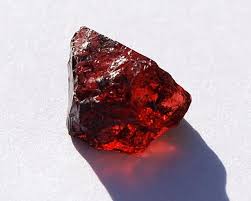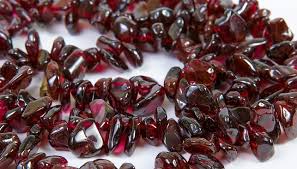
Garnet is the traditional birthstone for people born in the month of January. This sparkling gemstone occurs in a wonderful spectrum of colors from the rich greenish tsavorite variant to the fiery orange Mandarin garnet. In fact, the January birthstone is one of the most exquisite stones you will find.
Pyrope garnet is the most common variant of garnet. This stone represents trust, loyalty, and friendship.
During ancient times, it is used to protect its wearers when traveling far and wide. According to legends and folklore, this stone has the power to light up the darkest of nights. You can also use this as your protection from dark, scary and spine-chilling night terrors and nightmares.
Table of Contents
- What’s The Color Of the January Birthstone?
- January Birthstone: Garnet Etymology, History, and Folklore
- The Spiritual Meaning of January Birthstone
- The Health Benefits and Healing Properties of the January Birthstone
- The Durability of the January Birthstone
- Caring and Cleaning January Birthstone
- How To Store Garnet?
- Can I Wear Garnet Jewelry Every Day?
- The Cost of January Birthstone
- Garnet Alternative: Secondary January Birthstones
- Conclusion
- Related Reading
What’s The Color Of the January Birthstone?
For most January-born people garnet evokes the thoughts of a red gemstone. However, this January birthstone is available in several other colors. Garnet comes in pinkish-orange, orange, green, purplish reds, and even the rare blues.
However, red garnet is the most common, sometimes tinged with violet, yellow and brown. The Tsavorite garnet, which is the green variety, is rare due to the metamorphic conditions in which it’s formed. It’s the extensive folding and refolding of the rock.
Even though all garnets feature the same crystal structure, they are different in chemical composition. The family of over 20 varieties of garnet is categorized and only 5 of these species have gemstone quality:
- Pyrope and Almandine (Red Garnets)
- Grossular (Yellow, Red, Brown and Green Garnets)
- Spessartine (Red-Brown to Orange Garnets)
- Andradite (Black, Green, Brown, Yellow or Red Garnets)
- Uvarovite (Green Garnet in crystal cluster)
Furthermore, the January birthstone also exhibits a color-change effect, where it changes in color depending on the type of light in which it is viewed.
Get A Free Downloadable Checklist of The 3 Best Crystals For Healing Each Of Your Chakras.
Give Me My Free ListJanuary Birthstone: Garnet Etymology, History, and Folklore
In ancient times, Garnet was referred to as the carbuncle. Eventually, it gets its name from the Middle English term “gernet” meaning “dark red” and the Old French term “grenate” meaning “pomegranate red”.
In addition, it is widely accepted that its name can be traced back to the Latin term “granatum” which means the seeded fruit, pomegranate with its vivid red seed covers that it resembles.
The January birthstone has a rich history that spans back over 5,000 years. It was believed to be used during the Bronze Age in Ancient Bohemia (now known as the Czech Republic). Ancient Egypt and its pharaohs also wore garnets as necklaces in life. Also, it is then believed to be taken to the afterlife as prized possessions. Around 2,100 BC, Garnet was introduced in Sumer and in Sweden between 2,000 and 1,000 BC.
Red garnets were the most highly traded gemstones in the Late Roman era. Also, they were especially used in garnet cloisonné’, a technique used to inlay gold cells. During the Middle Ages, people from the European countries used this gemstone for enhancing truth, consistency, and faith as well as dispelling depression and sadness.
A powerful protective stone and known as the “warrior’s stone”, it was used as a talisman during the Great Crusades by both Muslims and Christians.
According to Christian tradition, the garnet’s blood-red color represents the sacrifice of Christ. Meanwhile, Jewish people believed that garnet is one of the 12 precious stones featured on Aaron’s iconic breastplate.
Additional Information

Koran speaks of garnet illuminating Jannah, who’s the fourth and final heaver of Muslims. In Hebrew mythology, the ark of Noah is said to be lit by a huge glowing red garnet. According to ancient Greeks, this stone can prevent children from drowning. You can also use it as a powerful antidote against poisoning. Native American Indians and African tribes also used garnet as well as the Aztecs and Mayans as decorations and ornaments.
Garnets can also protect you and offer complete invulnerability from life-threating wounds while inflicting them. For this reason, Asiatic clans use these gems for their bows. It is also used as bullets by the Hanza tribe during 1892 as they waged war against the British army.
They believed that this blood-colored stone would result in fatal, deeper wounds than the lead bullet. A large number of these bullets were then collected by the British troops and you can see them in their museum today.
According to folklore, the garnet gemstone can warn its owner of danger. Historians recorded that if a garnet loses its luster and sheen, then it can be an indication of imminent danger.
In addition, garnet has been used as an exchanging gift between couples to celebrate their wedding anniversaries. Traditionally, garnet was given on the 19th wedding anniversary. However, it is now considered to be a 2nd wedding anniversary gemstone.
The Spiritual Meaning of January Birthstone
Garnet can help you in using your creative prowess. When tied to the Earth intimately, garnet helps in keeping you grounded and live happily, despite the ups and downs.
In addition, Garnet is also a sensual stone, denoting the primordial fire which is the inception of the universe from chaos and the eventual purification and resulting love.
Connected to the word pomegranate, Garnet represents the quick reunion of separated lovers, like the Greek myth telling how Hades give a pomegranate to Persephone in order to ensure her speedy return. For this reason, it is a nice gift to give your loved ones before going on a trip.
The Health Benefits and Healing Properties of the January Birthstone

Garnet helps in restoring your health, rejuvenate your love life, boost your creativity and protects you from all kinds of diseases.
Since the most common variants of garnet are red, people associate this to heart and blood. Thus, it regulates and encourages good blood flow of the cardiovascular system. It is also beneficial in curing a lot of inflammatory ailments and preventing and treating hemorrhage.
Not only that, but it also helps promote the production of hemoglobin, and stimulating your metabolism. It will also re-energize the body, preventing cellular ailments and helping in assimilating minerals and vitamins.
For women, wearing garnet jewelry can promote hormonal balance as well as reducing swelling. For men, garnet jewelry can help cure lung ailments and heart palpitations. It can also treat several conditions associated with the circulatory system such as erectile dysfunction.
Not only for physical healing, but garnets are also powerful psychic and mental health healers. It induces loyalty, passion, trust, self-confidence, devotion, truth, positive energy and friendship. In ancient times, it helps in resisting sadness, wading away evil, negative spirits and warding off haunting nightmares and memories.
The stone can also assist in overcoming mental problems like depression and anxiety. It can also reduce negative and destructive behavioral patterns. It also helps people struggling with the loss of a partner or a loved one, soothing the emotional turmoil, providing a feeling of solace and rejuvenating the soul.
Lastly, it ignites deep-seated emotions in terms of passion and love, stimulating your sex drive, and boosting fertility.
The Durability of the January Birthstone
There are three factors that affect the durability of a gemstone. First, its resistance to scratching (hardness). Second, its resistance to breakage, cracking and chipping (toughness). Lastly, its resistance to environmental or chemical shock (stability).
Garnet Hardness

Because of its diversity, garnet ranges from 6.5 – 7.5 on the Mohs hardness scale. As a result, special care is needed when cleaning, wearing and storing the softest species of garnet which are uvarovite and andradite, with a hardness range of 6.5 – 7 in order to avoid scratches on the gemstones.
You can wear the hardest garnet species `every day in all kinds of jewelry like Pyrope and Almandine with the narrowest hardness range of 7 – 7.5. Meanwhile, grossular and spessartine have the broadest hardness range of 6. – 7 that can resist scratch but still need to be worn with caution.
Garnet Toughness
These stones are brittle in some degree since they’ll eventually cleave or break when struck with enough force. The toughness in gemstones is rate from poor (lowest), fair, good, excellent or exceptional (highest).
And garnet has a fair toughness, making it a durable stone for all kinds of jewelry.
Garnet Stability
Garnet is a highly stable gemstone. Although it can deteriorate when hydrofluoric acid is used. High thermal shock and temperatures can also cause fractures in garnet, thus they should be avoided.
Caring and Cleaning January Birthstone
How To Clean Garnet?
The safest way to clean your garnet gemstone is by washing it with warm water and soap and a soft brush.
In addition, you can use ultrasonic cleaners, although professionals do not recommend this since the vibrations loosen settings. However, you shouldn’t use ultrasonic cleaners in cleaning treated garnet that has fracture filling.
After cleaning, you can rinse the gemstone with clean water and drying it with a soft cloth.
How To Store Garnet?
Although durable, garnet can incur damage if not properly stored. You need to separate every piece of garnet from other stones and pieces of jewelry in its own fabric compartment. Then place it in a dry and cool place.
You can also use acid-free paper envelopes called “diamond papers” or parcel paper envelopes” ito store garnets. For those who want to showcase this gemstone, a glass jar with fabric or foam inserts are perfect.
Can I Wear Garnet Jewelry Every Day?
Of course! The durability of garnet is suitable for everyday wear, especially for pendants, earrings, and brooches. Why? Because these pieces are less likely to knock against a hard surface. Garnets used in bracelets and rings, but, they should be used occasionally.
The Cost of January Birthstone
Garnet pendants are popular with jewelry designers and may include all kinds of shapes. For instance, a 1.3 carat, heart-facet, green garnet can cost over $900. Earrings, on the other hand, also makes a nice gift. And a pair of 0.5 carats, demantoid garnet can go as low as $150 or you can even get a cheaper one— a 2.8 carat, square-cut, red pyrope garnet only costs as low as $50.
Rings, however, can go over $100 for the 2.5 carats, red hessonite garnet. For bracelets or necklaces, you can purchase garnet at a reasonable price. A 4-piece set of 2-carat pyrope garnet can only cost you $75. Or if you like the rare green one, then a 20 piece of 0.12 carat can go for $200.
Garnet Alternative: Secondary January Birthstones
Garnet is the only birthstone for people born in January across the spectrum of calendars from the traditional to modern Russian, Roman, and Ayurvedic.
However, when it comes to astrology, you get 2 zodiac signs for January: Aquarius, and Capricorn. This gives you the option of sugilite, opal, moss agate, and amethyst for Aquarius and onyx, agate, and ruby for Capricorn.
Conclusion
Garnet is a highly versatile birthstone for people born during the first month of the year. With it is a wonderfully fascinating history of its culture and healing properties.
A good protective and healing stone, garnet wards off negative thoughts, cleanse the blood, and stimulating your circulatory system, giving it a strong connection to emotional matters of the mind and heart.
Related Reading
Felicia Eisnnicher
I am the Lead Author and Editor at Gemstagram. I am responsible for creating and editing content about the power of gems and crystals. I also teach about self-knowing, self-understanding and personal empowerment through numerology. My mission is to help people understand the power of gems and crystals, and how they can use that power to improve their lives. I believe that by understanding ourselves better, we can become more empowered individuals who are able to create our own destiny.Visit my profile page for more information about me: Felicia Eisnnicher Author Profile
Get A Free Downloadable Checklist of The 3 Best Crystals For Healing Each Of Your Chakras.
Give Me My Free List

